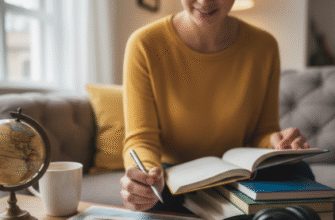The scent of rain on hot asphalt in a new city, the taste of a street food dish you can’t pronounce, the distant sound of music drifting from an open window—these are the real souvenirs of travel. Yet, how often do these vivid sensory details fade into a generic blur of “a great trip” a few months later? We return with a camera roll full of posed smiles and landmark selfies, but the soul of the experience can feel just out of reach. Documenting your travels like a professional isn’t about having the most expensive camera or a massive social media following. It’s about consciously creating a rich, multi-sensory archive of your journey, one that can transport you back to that exact moment, years down the line.
It’s time to move beyond the obligatory photo dump and start building a narrative. Your travels tell a story, and you are the storyteller. The goal is to capture the texture, the atmosphere, and the personal transformation that happens when we step outside our daily routines. This guide is about embracing different methods to create a travel log that is as unique and vibrant as the adventure itself.
Beyond the Landmark Selfie: Visual Storytelling
Photography is often our primary tool for documenting travel, but our approach can make the difference between a forgettable snapshot and a powerful memory trigger. The key is to think like a photojournalist telling the story of a place, with you as the main character. It’s less about proving you were there and more about conveying what it felt like to be there.
Capture the In-Between Moments
The most iconic photos from your trip might not be of the Eiffel Tower or the Colosseum. They might be the shot of your travel partner laughing at a shared joke in a tiny cafe, the close-up of a baker’s flour-dusted hands, or the view from your train window as the landscape blurs by. These candid, unposed moments are often the most authentic. They capture the feeling of the journey, not just the destination. Look for patterns, textures, light, and shadow. A photo of a colorful doorway, a cobblestone street glistening after a rain shower, or a stack of local newspapers can say more about a place than another wide shot of a crowded square.
Try this exercise: for every one “big” landmark you photograph, challenge yourself to take five photos of small details within a 50-meter radius. It forces you to slow down and observe the environment in a new, more intimate way.
The Power of People and Portraits
A place is defined by its people. While being respectful of privacy and local customs is paramount, capturing portraits (with permission, of course) can add incredible depth to your travel story. A portrait of a smiling market vendor, a thoughtful artisan, or a group of children playing tells a story of the local culture. Don’t just focus on the people you meet; turn the camera on yourself and your companions in a more thoughtful way. Instead of a selfie, have someone capture you looking out at a view, interacting with a local, or navigating a map. These environmental portraits place you within the scene, creating a much more evocative memory.
The Written Record: Your Personal Travelogue
A picture may be worth a thousand words, but some things can only be captured with language. The nuances of a conversation, the complexity of your own feelings, the backstory of a place—these are the domain of the written word. A travel journal is your most personal and powerful documentation tool.
It’s crucial to find a balance between documenting and experiencing. Don’t live your entire trip through a screen or a notebook. Set aside specific times for writing or photography, such as the morning over coffee or in the evening before bed, so you can remain fully present in the moment the rest of the time. The goal is to enhance the memory, not replace the experience itself.
What to Write When You Don’t Know What to Write
The blank page can be intimidating. Forget trying to write a literary masterpiece. Your travel journal is for you. Here are some prompts to get you started:
- The Five Senses: For each day, write down one thing you saw, smelled, heard, tasted, and touched that was unique to that place. For example: “Saw the brilliant turquoise of the sea,” “Smelled the salty air mixed with sunscreen,” “Heard the cicadas buzzing in the olive trees,” “Tasted the sharp feta in the salad,” “Felt the grit of sand between my toes.” This practice anchors your memories in physical sensation.
- Highs, Lows, and Surprises: Document the best part of your day, the most challenging moment, and something that completely surprised you. Travel isn’t always perfect, and recording the challenges provides a more honest and often humorous look back.
- Conversations and Quotes: Did a tour guide say something profound? Did you have a funny exchange with a shopkeeper? Jot down snippets of conversations. These little lines of dialogue can bring a memory roaring back to life.
Physical vs. Digital Journaling
There’s no right answer here—only what works for you. A physical notebook and a good pen offer a tactile, screen-free experience. You can tape in ticket stubs, receipts, and postcards, turning it into a scrapbook as you go. Digital journaling, on the other hand, is convenient and searchable. You can use a simple notes app or a dedicated journaling app that allows you to easily embed photos, location tags, and audio clips right alongside your text. The best method is the one you’ll actually stick with.
The Art of Collecting: Curating Your Memories
Beyond cheap souvenirs, think of yourself as a curator of your own travel museum. Collecting small, flat items of ephemera can be one of the most rewarding ways to document a trip. These objects are tangible pieces of your journey, each with a story embedded within it.
Think Like a Curator
What items represent your experience? Don’t just grab a magnet at the airport. Consider collecting things like:
- Tickets and Stubs: Train tickets, museum passes, concert stubs.
- Paper Goods: Postcards (write a memory on the back before you file it away), interesting business cards from restaurants, local maps with your route drawn on them.
- Currency: A few coins or a small-denomination bill.
- Local Packaging: A unique candy wrapper, a beer bottle label, or a tea tag.
When you get home, you can arrange these items in a shadow box, paste them into your journal, or store them in a dedicated “memory box” for that trip. Opening that box years later and holding a metro ticket from Paris or a wrapper from a Japanese snack is a surprisingly powerful form of time travel.
This process of active collecting also changes how you see your surroundings while you travel. You start to notice the graphic design on a cafe’s napkin, the texture of a theater ticket, and the unique typography on a sign. It’s another way to deepen your observation and engagement with the world around you.








